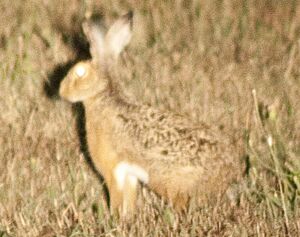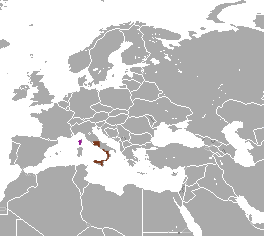Corsican hare facts for kids
Quick facts for kids Corsican hare |
|
|---|---|
 |
|
| Conservation status | |
| Scientific classification | |
| Genus: |
Lepus
|
| Species: |
corsicanus
|
 |
|
| Corsican hare range | |
The Corsican hare (Lepus corsicanus), also called the Apennine hare or Italian hare, is a special type of hare. You can find it in southern and central Italy and on the island of Corsica. These hares are known for their speed and ability to hide well in their natural homes.
Contents
Discovering the Corsican Hare
This unique hare was first officially described in 1898. A British zoologist named William Edward de Winton gave it its name. He studied hares found on the island of Corsica.
For a while, some scientists thought the Corsican hare was just a type of European hare. Others even thought it was a kind of Cape hare. But today, most scientists agree it is its own distinct species. This is because it does not mix with European hares, even when they live in the same areas. Also, studies of its DNA show it has a unique family history. It developed separately during the last Ice Age.
What Does a Corsican Hare Look Like?
The Corsican hare looks a lot like the European hare. It has mostly brown fur with a creamy white belly. One way to tell them apart is by looking at the fur close up. The Corsican hare has grey bases to its underfur hairs, not white ones.
These hares are usually smaller than European hares. Their head and body are about 44 to 61 centimeters (17 to 24 inches) long. Their tail is shorter, around 6.6 to 11.2 centimeters (2.6 to 4.4 inches). They weigh between 1.8 and 3.8 kilograms (4 to 8.4 pounds). Corsican hares also have longer ears and hind legs compared to their body size. Their ears can be 9 to 12.6 centimeters (3.5 to 5 inches) long. Their powerful hind legs are about 11.4 to 13.5 centimeters (4.5 to 5.3 inches) long. These long legs help them run very fast!
Where Do Corsican Hares Live?
You can find Corsican hares in different types of places. They like maquis shrubland, open grasslands, and even farm fields. They also live in sandy areas near the coast, called dunes.
They are very common on the island of Sicily. There, they live from sea level all the way up to 2,400 meters (7,900 feet) high on Mount Etna. In mainland Italy, their homes are more spread out. They live in patches as far north as Tuscany on the west coast. On the east coast, they can be found near Foggia.
Humans brought Corsican hares to the island of Corsica a long time ago. This probably happened between the 14th and 17th centuries. Today, they are quite rare on Corsica. Only a few have been seen recently.
Protecting the Corsican Hare
Sadly, the number of Corsican hares seems to be going down. Because of this, the International Union for Conservation of Nature (IUCN) lists them as a "Vulnerable" animal. This means they are at risk of becoming endangered.
Several things threaten these hares:
- Habitat loss: Their natural homes are disappearing due to human development.
- Hunting: Even though they are now protected from hunting, it's hard to enforce. This is because they look so much like the European hare.
- Competition: They have to compete for food and space with European rabbits. They also compete with European hares that have been introduced to their areas.
Efforts are being made to protect the Corsican hare. It is now illegal to hunt them. But more work is needed to make sure these special hares can thrive in their natural habitats.


